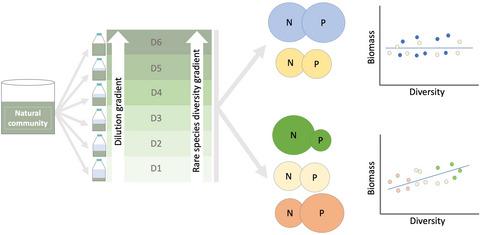Our official English website, www.x-mol.net, welcomes your
feedback! (Note: you will need to create a separate account there.)
Environmental stoichiometry mediates phytoplankton diversity effects on communities' resource use efficiency and biomass
Journal of Ecology ( IF 5.3 ) Pub Date : 2021-11-08 , DOI: 10.1111/1365-2745.13811 Miriam Gerhard 1 , Alexandra Schlenker 1, 2 , Helmut Hillebrand 1, 3, 4 , Maren Striebel 1
中文翻译:

环境化学计量介导浮游植物多样性对社区资源利用效率和生物量的影响
更新日期:2021-11-08
Journal of Ecology ( IF 5.3 ) Pub Date : 2021-11-08 , DOI: 10.1111/1365-2745.13811 Miriam Gerhard 1 , Alexandra Schlenker 1, 2 , Helmut Hillebrand 1, 3, 4 , Maren Striebel 1
Affiliation

|
- Positive biodiversity–ecosystem functioning (BEF) relationships are predicted to increase in strength when high environmental variability allows for complementarity between resource use strategies in diverse communities. This environmental variability can be represented by spatial or temporal variation in nutrient ratios, but resource use efficiency (RUE) and therefore biomass build-up of primary producers might be restricted when nutrient ratios are highly imbalanced (i.e. limitation by one nutrient and beyond optimal ratios for growth). Although the linkages between ecosystem functioning, diversity and nutrient availability are theoretically well understood, we lack experimental evidence on how phytoplankton diversity affects resource use and biomass under variable nutrient ratios (N:P ratios).
- Combining a mesocosm and a microcosm experiment, we tested diversity effects on ecosystem functioning by exposing a species diversity gradient generated by the loss of rare species in a natural community to different N:P ratios (uniform vs. a gradient). The N:P supply ratio gradient also allowed us to evaluate responses across balanced and imbalanced ratios.
- We found that increased species diversity led to increased community RUE when supplied a gradient of N:P ratios; but restricted to the highest diversity level. However, diversity did not affect RUE under uniform nutrient ratios. The overall phytoplankton biomass and carbon:nutrient ratios responses to diversity reflected the patterns detected for RUE. Contrary to theoretical predictions, RUE was maintained under highest N:P supply ratios (extreme phosphorous limitation) suggesting that imbalanced N:P ratios do not necessarily decrease function. Thus, we showed that the nutrient context influences diversity effects on RUE and biomass.
- Synthesis. Overall, our results suggest that the effect of rare phytoplankton species losses on community RUE and biomass can be compensated by the persistent species when nutrient ratios are uniform, but leads to decreases in ecosystem functioning under variable nutrient ratios. This work provides a first attempt for testing interactions between the nutrient context (including concentrations and ratios) and the diversity of (natural) communities experimentally, which is conceptually understood but poorly tested for phytoplankton.
中文翻译:

环境化学计量介导浮游植物多样性对社区资源利用效率和生物量的影响
- 当环境的高度可变性允许不同社区的资源使用策略之间具有互补性时,积极的生物多样性-生态系统功能 (BEF) 关系预计会增强。这种环境变异性可以通过养分比例的空间或时间变化来表示,但是当养分比例高度不平衡时(即受一种养分限制和超出最佳比例),资源利用效率(RUE)和初级生产者的生物量积累可能会受到限制增长)。虽然生态系统功能、多样性和养分可用性之间的联系在理论上得到了很好的理解,但我们缺乏关于浮游植物多样性如何在可变养分比率(N:P 比率)下影响资源利用和生物量的实验证据。
- 结合中宇宙和微观宇宙实验,我们通过将自然群落中稀有物种丧失所产生的物种多样性梯度暴露于不同的 N:P 比率(均匀与梯度)来测试多样性对生态系统功能的影响。N:P 供应比率梯度还使我们能够评估平衡和不平衡比率的响应。
- 我们发现,当提供 N:P 比率梯度时,增加的物种多样性会导致群落 RUE 增加;但仅限于最高的多样性水平。然而,在统一的养分比例下,多样性并不影响 RUE。总体浮游植物生物量和碳:养分比率对多样性的反应反映了检测到的 RUE 模式。与理论预测相反,RUE 维持在最高 N:P 供应比率(极端磷限制)下,这表明不平衡的 N:P 比率不一定会降低功能。因此,我们表明营养环境影响对 RUE 和生物量的多样性影响。
- 合成。总体而言,我们的研究结果表明,当养分比例一致时,稀有浮游植物物种损失对群落 RUE 和生物量的影响可以通过持久物种补偿,但在不同养分比例下会导致生态系统功能下降。这项工作首次尝试通过实验测试营养环境(包括浓度和比例)与(自然)群落多样性之间的相互作用,这在概念上得到了理解,但对浮游植物的测试却很差。











































 京公网安备 11010802027423号
京公网安备 11010802027423号